Contributed by Matthew Wright
Dear friends, and you who are following or joining us in our online The Wisdom Jesus book study,
We meet early next week to take a deep dive into Chapters Three-Five, “The Kingdom of Heaven is Within You,” “The Path of Metanoia,” and “A Gospel of Thomas Sampler.” All three of these sections revolve around the question that opens Chapter Three—”What did Jesus actually teach?” Cynthia points us back to the words of St. Paul: “Let the same mind be in you that was in Christ Jesus” (Phil. 2:5), and then reminds us that what is central to the Jesus path is “not just admiring Jesus, but acquiring his consciousness.”
How do we put on the mind of Christ? How do we see through his eyes? How do we feel through his heart? How do we learn to respond to the world with the same wholeness and healing love?”
These questions, Cynthia says, are at the heart of Christianity—and they’re more about right practice than right belief.
Crucially, she argues that the “Kingdom of Heaven”—the very heart and bedrock of all Jesus’ preaching—is not “the place we go when we die” but rather a state of consciousness. Jesus tells us that the Kingdom is “within you” (that is, here) and “at hand” (that is, now). It’s reality perceived through a different “operating system” that does not see from separation—no separation between God and humans, between humans and other humans, or between humans, God, and creation. This mode of seeing is what today we would call unitive or nondual consciousness.
We come into the world with an egoic or binary operating system—we perceive by way of either/or, this and that, us vs. them. This mode of perceiving isn’t a problem, per se—it’s a useful tool for functioning in this realm—but it is limited, and too often we mistake it for our only mode of perception. We have the capacity, however, to bring online another mode of perception, called in the Christian tradition “seeing with the eye of the heart.”
The heart in this tradition is understood not simply as the seat of our emotions, but as an organ of spiritual perception—the faculty within us that has the ability to see from oneness. Rather than reading the quantitative universe (that’s the job of our rational intellect), the heart reads the qualitative universe—that realm of qualities that can’t be measured by the mind—things like love, truth, and beauty.
The heart sees from wholeness, and reads reality by way of resonance—from the inside out. Jesus spoke to this capacity when he said: “Blessed are the pure [or unified] in heart, for they shall see God.” In other words, when the heart is purified we literally see God—not in an afterlife when we die, but here and now as the very Oneness of Being, or “the One in whom we live, and move, and have our being,” again in the words of St. Paul (Acts 17:28).
The early Desert Mother and Fathers tell us that they worked in their own spiritual practice to “put the mind in the heart”—moving attention from the head, where we tend to stake our seat of selfhood, and into the heart center. Little by little, they found, this purifies the heart and strengthens its knowing. Working within this tradition, St. Theophan the Recluse writes:
Attention [placed in the heart] gives birth to warm tenderness of heart, which in turn increases attention. They grow in strength together, supporting each other. They give depth to prayer, gradually quickening the heart: banishing distraction and wandering thoughts, they bestow on prayer its purity.
And again:
When attention descends into the heart, it attracts all the powers of the soul and body into one point there. This concentration of all human life in one place is immediately reflected in the heart by a special sensation that is the beginning of future warmth. This sensation, faint at the beginning, becomes gradually stronger, firmer, deeper.
You might try working with this practice now—perhaps first feeling the way in which attention can be moved through the body—placed in the hands, or the feet—and then moving attention into the space of your chest, feeling that you are “breathing through you heart.” Let the breath and the heartbeat serve as anchors for your awareness, allowing the mental center to quieten down. If you work with a sacred word, as in Centering Prayer, you might try placing the word “in the cave of the heart” as you repeat it, rather than in your head.
St. Theophan writes:
Whether it be the Jesus prayer or any other short prayer, it is good if it is always in the mouth. Only take care that the attention is in the heart and not in the head, and hold to this not only when standing in prayer but at all other times as well.
The heart is the doorway to repentance, which Cynthia takes up in Chapter Four. As Jesus continually cries, “Repent, for the Kingdom of God is at hand.” This does not mean, however, “Emotionally beat yourself up for your sins because the world is about to end!” Cynthia reminds us that our English word “repentance” comes from the Greek word metanoia, from meta (beyond, or larger) and noia (mind). And so, repentance might well be translated as “to go beyond the mind” or “to go into the Larger Mind.” And so Jesus is saying, “Go beyond the dualistic mind, and discover that the Kingdom of God is right here and now.”
Cynthia reflects beautifully on the Beatitudes and their centrality to the Jesus path (pp. 42-47), which I will not summarize here. Then she opens a conversation about Jesus’ parables, noting that they are in many ways like Zen koans—stories that can’t be worked out at the level of the rational mind, but that are instead meant to short-circuit it, opening another way of seeing—opening the heart.
Take, for example, the parable of the workers who enter the vineyard at different times of day, and at the day’s conclusion are all paid the same amount. The calculating mind is left screaming, “That’s not fair.” Only the heart can understand.
This finally leads to a discussion of those teachings known as “the hard sayings” of Jesus—sayings that don’t fit into our picture of “nice Jesus” who “welcomes everyone”; these are parables like the story of the man thrown out of the wedding banquet for not wearing a “wedding garment” or the “wise bridesmaids” who refuse to share their oil with the “foolish bridesmaids” who are similarly cast out of the wedding for not having their lamps lit when the bridegroom arrives.
Cynthia points out that these teachings are not about the outer, social dimension of the Gospel (be kind, share, etc.) but are rather about the inner work we all must do, which no one else can do for us. She writes: “The oil stands for the quality of your transformed consciousness, and unfortunately, it’s impossible to become conscious unconsciously, through a donation from somebody else.” This emphasis on inner work becomes all the more explicit in The Gospel of Thomas, which brings all of these “hard sayings” into clear focus. In the remaining section, Cynthia offers commentary on some core Thomas teachings.
For the uninitiated, The Gospel of Thomas is a collection of 114 sayings attributed to Jesus; in its opening words, it claims to have been recorded by “Judas Didymos Thomas.” This likely refers to Thomas the apostle, known from the New Testament (a.k.a. “Doubting Thomas”). Thomas is not a narrative gospel like the more familiar texts of Matthew, Mark, Luke, and John—that is, it doesn’t tell the story of Jesus. Instead, it presents itself as a collection of his Wisdom teachings, most of them introduced simply with the words, “Jesus said.”
For centuries, Thomas had been assumed lost. We knew it once existed because early Christians mentioned it in their writings, but we had no surviving copies—until one showed up in 1945, discovered by a farmer in a cache of manuscripts buried in a large clay jar in the Egyptian desert. These texts are now known as the “Nag Hammadi Library,” and the version of Thomas recovered from them is a Coptic translation of an originally Greek text. It has revolutionized our understanding of what Jesus taught.
About half of the sayings of Jesus in Thomas have an equivalent in the canonical Gospels; the other half are “new” sayings—and they round out masterfully the inner dimensions of Jesus’ teaching. If you’d like to explore Thomas a bit further, I’ve written three introductory pieces on the text which you can find here:
Approaching Thomas; Engaging Thomas; Becoming Thomas.
In Thomas, the nondual understanding of the Kingdom of God doesn’t need to be guessed at—it is stated with stunning clarity. For example, Saying 22:
Jesus said to them, “When you make the two into one, and when you make the inner like the outer and the outer like the inner, and the upper like the lower, and when you make male and female into a single one, so that male will not be male nor female be female… then you will enter the kingdom.”
This is of course reminiscent of St. Paul’s words, “There is neither Jew nor Gentile, neither slave nor free, neither male nor female, for you are all one in Christ Jesus.” We see Jesus pointing us here to the deep down Oneness, beneath the surface appearance of things—the truth that is always seen with the eye of the heart. The Sufi poet Rumi, standing in that long lineage of heart-centered Wisdom of which Jesus was so obviously a master, says it more beautifully than I ever could; I’ll give him the last word:
You have two hands, two legs, and two eyes, But if your heart and the Beloved are also two, what good is that?
You call out, I am the lover, But these are mere words. If you see lover and Beloved as two, you either have double vision or you can’t count.
May we each, little by little, and more and more, open the eye of our hearts; may we repent—that is, go beyond the mind—and discover, here and now, the kingdom of Oneness, spread out all around us. Amen.
Images from the top: Cover of The Wisdom Jesus, courtesy of Northeast Wisdom; Icon of St. Theophan the Recluse, Copyright © 2014 Orthodox Christian Supply. All rights reserved, courtesy of their website; Solomon Raj, “Jesus on the Lotus Flower” (1998), copyright credit to Solomon Raj, courtesy of the New York Times; First page of Gospel of Thomas Codex II, public domain, courtesy of Wikipedia; The Chinese-born artist James He Qi’s “Peace, Be Still” (1998), copyright credit to James He Qi, courtesy of the New York Times.
Wisdom Jesus Book Circle
A monthly series of resources from the friends and leaders of the Wisdom Waypoints Book Circle Series on: The Wisdom Jesus: Transforming Heart and Mind—A New Perspective on Christ and His message by Cynthia Bourgeault.



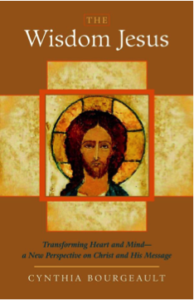
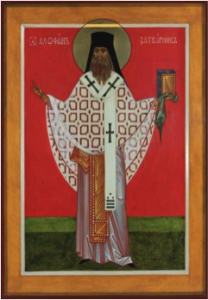
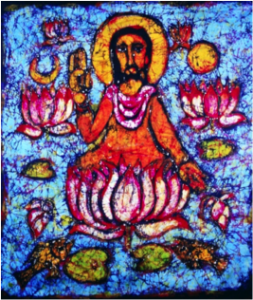
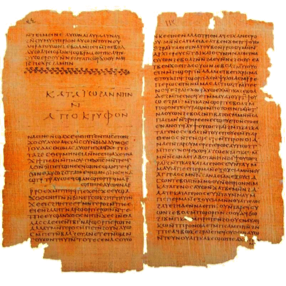
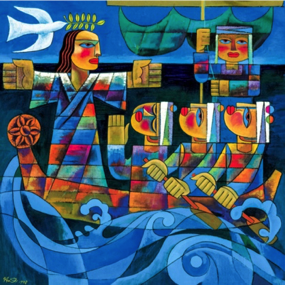
My understanding is that we are born with a unitive operating system. We are one and are born one. The egoic or binary operating system is the result of conditioning and indoctrination. We learn separation or dualism, which dominate for a while. We seem to need some time before we are born again and awaken into awareness that we and God and all creation is one. We are in the world of appearance of separation but of the reality of oneness.
Am I correct in saying that the book circles is closed?
Thank you Matthew. I really enjoyed reading this and it is so appropriate for Lenten reflection. I am going to try and embed some of the principles in my Centering Prayer Group. I might be thrown into prison for heresy here in my conservative community, but it’s worth a very subtle attempt.
How do we join the current study that Matthew is teaching?